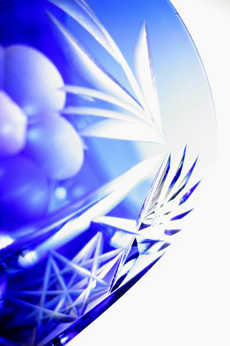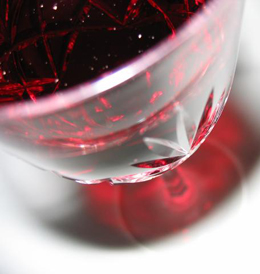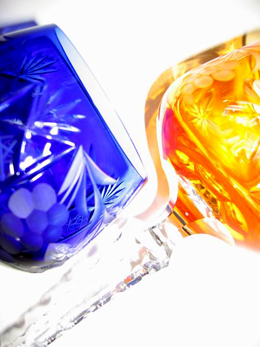

A beautiful cut crystal goblet is safe to drink from, but leaving your Port in a crystal decanter could be a health hazard. All photography by Rose Vita | MorgueFile.
August 2007
|
 |
Product Reviews / Main Nibbles / Wine
Is There Danger In That Decanter?
Safety, Health and Lead Crystal
CAPSULE REPORT: Ordinary glass has been made for thousands of years from silica-sand, potash and limestone. Ancient cultures also carved rock crystal into beads, figurines and dishes. In 1674, lead crystal was made successfully in England by George Ravenscroft, who added lead oxide to glass. Its beauty has been admired ever since; however, recent studies have shown that high percentages of lead can leach into liquids stored in lead crystal. Danger, Will Robinson! While you don’t have to throw out the crystal stemware, if you don’t own it yet and have the slightest concern, you might prefer to buy beautiful glass stemware instead. But for complete safety, and to avoid any health issues, don’t store Cognac or Port in a crystal decanter or store jam in lead crystal jam pots. Serve it, enjoy the beauty of the container, and then return the spirits or jam to their regular containers.
Many people like to set a fine table with beautiful crystal, also known as lead crystal. Crystal is leaded glass: Lead oxide is added to the molten glass before it is blown (stemware, tumblers, barware, decanters, pitchers and other holloware) or molded (figurines, objects d’art, jewelry and other objects). After hardening, “glassware” is often hand- or machine-cut with facets. The facets look like crystals, no doubt leading to the evolution of the product from its original name, flint glass, to lead crystal and cut crystal. (Regular glass can also be faceted, but the lead makes the glass softer and easier to cut.)
The lead content also provides a much higher index of light refraction than normal glass, and consequently much greater “sparkle.” Lead crystal has a brilliant, silvery appearance and a ringing clink, compared to the “tinny” quality of ordinary glass. The grand sound of toasting by clinking crystal glasses is a musical sound.
Crystal can consist of up to 33% lead—the more lead, the more sparkle and ping. Lead crystal typically contains 24% to 32% lead oxide. The higher lead content, the more difficult it is to form the crystal during blowing, the greater the skill of the glassblower, and the more expensive the object.
 Crystal was invented by George Ravenscroft (1618-1681), who established a glasshouse in London in 1673. In 1674 he patented a process for “flint glass” by adding lead oxide. While Ravenscroft did not invent cut glass, the art form came into prominence during this time, and lead crystal was the perfect medium to show off the artistry of cut glass. Crystal was invented by George Ravenscroft (1618-1681), who established a glasshouse in London in 1673. In 1674 he patented a process for “flint glass” by adding lead oxide. While Ravenscroft did not invent cut glass, the art form came into prominence during this time, and lead crystal was the perfect medium to show off the artistry of cut glass.
Today, companies such as Baccarat (France), Mikasa (France)*, Orrefors (Sweden) and Waterford Crystal (Ireland) are known for their crystal stemware, carafes and tableware. Still other prominent crystal companies like Steuben Glass (U.S.) and Swarovski (Austria) focus their work on collectibles, jewelry and other items.
*Mikasa originally was founded in the U.S. and produced its products in Japan. Today it is owned by Arc International, a French company.
Leaching Lead
After centuries of enjoying beautiful lead crystal at table, it has recently come under the scrutiny of health authorities, who were testing paint and other products as possible sources of lead poisoning. Preliminary tests have shown that, over time, significant amounts of lead can migrate from lead crystal containers into liquids stored in them.
- One research team measured the amount of lead migration in Port wine that was stored in lead crystal decanters. After two days, lead levels were 89 micrograms; after four months, lead levels were between 2,000 and 5,000 micrograms.
- White wine doubled its lead content within an hour of storage, and tripled it within four hours.
- Brandy stored in lead crystal for five years had lead levels around 20,000 micrograms.
- Any liquid can leach lead from crystal just as effectively as wine and other alcoholic beverages.
To put these numbers into perspective, the EPA’s lead standard for drinking water is 50 micrograms per liter.
What should you do?
 You can safely use your lovely crystal stemware to serve wine, water and other beverages. No liquid stays in the glass long enough during any meal to leach lead that exceed EPA standards. You can safely use your lovely crystal stemware to serve wine, water and other beverages. No liquid stays in the glass long enough during any meal to leach lead that exceed EPA standards. - Don’t store Cognac, Port and other alcoholic beverages in decanters. If you want to use your beautiful crystal decanters for entertaining, decant the alcohol into the decanter prior to serving, and decant it back into the original bottle at the end of the evening.
- The same goes for crystal jam pots. After breakfast or brunch, transfer the jam back into its glass jar.
Sources:
- CurrentSeparations.com:
“Determination of Lead Leaching
Migration from Crystal Glass by
Square Wave Stripping Voltammetry,” by Lorraine M. Whitney and Michael J. Hynes
- Pubmed.Gov
- Wikipedia
Lifestyle Direct, Inc. All rights reserved. Images are the copyright of their respective owners.

|